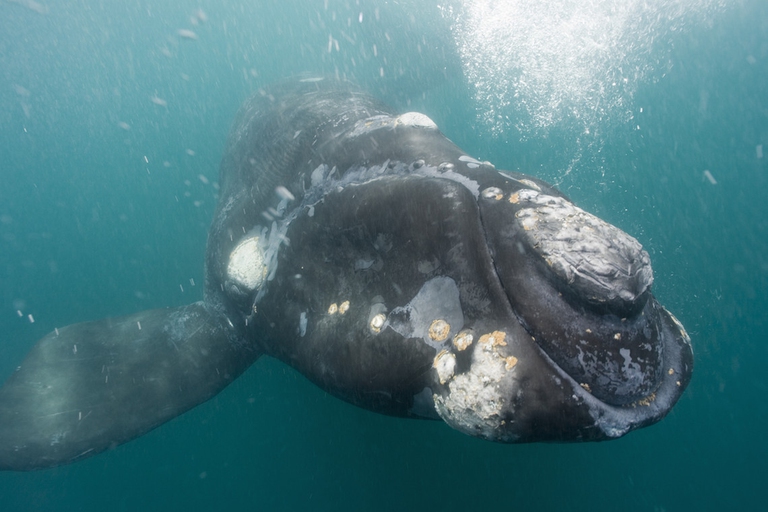
A group of experts in Tokyo suggested pouring radioactive water from Fukushima into the open sea. A marine biochemist explains the consequences of this absurd decision.
While most species of large whales are recovering from the collapse caused by commercial exploitation in the past two centuries, some populations are still struggling. A recent report, authored by experts of the Marine Mammal Commission in the U.S., reviews their status and highlights the main threats that these giants of the oceans are currently
While most species of large whales are recovering from the collapse caused by commercial exploitation in the past two centuries, some populations are still struggling. A recent report, authored by experts of the Marine Mammal Commission in the U.S., reviews their status and highlights the main threats that these giants of the oceans are currently facing. The assessment is based on the criteria used by the International Union for Conservation of Nature (IUCN)’s Red List of Threatened Species.
Baleen whales are cetaceans that use baleen plates – filtering structures made of keratin, the same protein found in our hair and nails, and attached to the upper jaw – to filter large quantities of water and extract food (krill or fish). The majority of the fourteen recognized species have been targeted by intense commercial whaling in the past centuries, which has driven them close to extinction. The moratorium implemented in 1986 by the International Whaling Commission stopped most whaling operations, with the exception of aboriginal whaling and research whaling (or whaling under objection to the moratorium) by Japan, Norway, and Iceland.
While causing international controversy and public contempt, current levels of whaling are not the most significant threat for most species. Other forms of human-caused mortality have been identified as the main obstacles to baleen whales’ recovery. These include by-catch, which is the accidental capture and entanglement in fishing nets, and ship strikes, the collision with large ships, a problem that is becoming more pressing as commercial traffic in the world’s oceans steadily increases. Other issues are ocean pollution, the spread of diseases, habitat degradation from oil spills and climate change, which is particularly problematic for those species that are restricted to small geographical ranges, with limited ability to move to new areas as the oceans warm up. Finally, baleen whales, like other marine mammals, can be disturbed by human activities, especially those that introduce noise in the environment (for example seismic surveys for oil and gas exploration) or directly harass the animals (such as unregulated whale watching).
Despite the common perception that all large whales are endangered, different species and populations within each species suffer a variable level of danger. Some populations have failed to recover from whaling exploitation and others remain threatened because of their smaller ranges. International research and management efforts are required to identify key impacts and coordinate effective conservation actions.
Siamo anche su WhatsApp. Segui il canale ufficiale LifeGate per restare aggiornata, aggiornato sulle ultime notizie e sulle nostre attività.
![]()
Quest'opera è distribuita con Licenza Creative Commons Attribuzione - Non commerciale - Non opere derivate 4.0 Internazionale.
A group of experts in Tokyo suggested pouring radioactive water from Fukushima into the open sea. A marine biochemist explains the consequences of this absurd decision.
The decline in grey and humpback whales in the Pacific and Atlantic Oceans has been traced to food shortages caused by rising ocean temperatures.
The United Nations has launched a major international alliance for ocean science, undertaking a mission close to all our hearts.
The cargo ship that ran aground off the coast of Mauritius on 25 July, causing incalculable damage, has split in two and its captain has been arrested.
The largest coral reef in the world is severely threatened by climate change, but researchers are developing strategies that could contribute to saving the Great Barrier Reef.
Seychelles have extended its marine protected area, which now covers over 400,000 square kilometres, an area larger than Germany.
Norwegian oil giant Equinor had pulled out of drilling for oil in the Great Australian Bight, one of the country’s most uncontaminated areas. A victory for activists and surfers who are now campaigning for the area to be protected forever.
30 per cent of the planet needs to be protected to stop precipitous species decline. The UN has set out its aims for the the COP15 on biodiversity scheduled for Kunming, China in October.
Ocean warming has risen to record highs over the last five years: just in 2019 the heat released into the world’s oceans was equivalent to that of 5-6 atomic bombs per second. The culprit, no doubt, is climate change.








